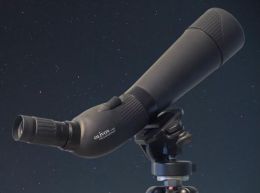How To Use a Spotting Scope For Astronomy?
- Posted By Jeff Byrnes
- Blog
 Spotting scopes might be specifically designed for use observing landbound or airborn subjects during the day, but the design of the glass is basically the same as a refractor telescope. In many ways, there is no real reason why a spotting scope cannot be used for stargazing and basic astronomy, as long as you take some considerations into mind.
Spotting scopes might be specifically designed for use observing landbound or airborn subjects during the day, but the design of the glass is basically the same as a refractor telescope. In many ways, there is no real reason why a spotting scope cannot be used for stargazing and basic astronomy, as long as you take some considerations into mind.
You can use a good spotting scope for viewing open clusters, planets like Saturn, Jupiter and its larger moons, as well as objects like Mizar, the Pleiades, and the moon. Just keep some things in mind.
Your eyepiece angle
A telescope designed for astronomy usually comes with an angled eyepiece, usually 90º to the barrel. This isn’t by accident or happenstance; it’s done to give you a more comfortable viewing angle. Spotting scopes, on the other hand, are usually of the straight variety or angled at 45º because they are designed primarily for looking downwards, level, and at shallow angles to the sky. They just aren’t designed for comfortable viewing high into the sky.
Because of this, you’ll usually need to either place your spotting scope on a very tall tripod, or place yourself lower to the ground for a more comfortable view. If you plan on using your spotting scope for astronomy or stargazing, I strongly recommend getting a model with a 45º viewing angle as opposed to a straight spotting scope. You can read my article on the differences between different types of spotting scopes to get more information on whether to choose a straight or angled spotting scope.
The objective lens size and aperture
Generally speaking, the larger the aperture, the more light your scope will capture. The aperture is the diameter of the objective lens, and this usually isn’t as critical for use during the day and in good light, but it’s vital for nighttime use. From my own experiences and research, I’ve found that a spotting scope with an objective lens of at least 65mm, but preferably 70mm, is fairly effective for basic astronomical use.
Budget accordingly
Bear in mind that using a spotting scope for nighttime use like stargazing or basic astronomy means using the scope at the extreme limits of what it might be capable of. Because of this, you may want to budget more for your spotting scope than you would otherwise. Getting a scope with much higher quality optics, better coatings, and high quality glass is going to be your preferred choice. If you can find a spotting scope that uses extra low dispersion glass (ED glass), that’s even better, because it will produce a brighter image with better quality, and will offer less color fringing around the edges of objects.
Summary
If your main intended use for a scope is astronomy, get a telescope. However, if you want an optic that can be used for viewing birds, wildlife, and also occasionally for taking a look at the night skies, there is no reason in the world why a good quality spotting scope won’t fit the bill. Once you’re ready to buy that spotting scope, make sure you check out our reviews.
This post was written by Jeff Byrnes
Hi there! I’m Jeff, an avid outdoorsman and hunter who really likes exploring new technology. I’m especially into hunting optics, which is why I’m writing these reviews! I hope you find my articles helpful in your own shooting and hunting.








